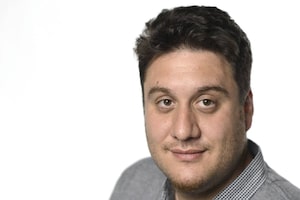Denis Villeneuve, left, with Jake Gyllenhaal on the set of Enemy.Caitlin Cronenberg
Toronto plays itself in Enemy, and it's a great performance. Other directors have tried their hand at putting Canada's biggest city onscreen, but Montreal filmmaker Denis Villeneuve is the first to think about making it look like Dubai. The imagery of hazy highways and glassy high-rises in this deceptively slender new thriller is indelible, even if a lot of Torontonians may end up wondering exactly when their hometown got so surreal.
"[Jose Saramago's] The Double is set in a sort of non-space," says Villeneuve, who was handed the novel by producer Niv Fichman a few years ago. "The story is about an individual wandering through a massive urban landscape, and so I wanted that sort of setting. The choice was between Sao Paulo and Toronto. Toronto is growing up so big, it's a fantastic playground."
There is indeed something playful about Enemy, which actually doubles down on the urban-wanderer trope the director describes: Its main character is a University of Toronto lecturer (Jake Gyllenhaal) who becomes increasingly convinced that he has a doppelganger living a few stops down the subway line.
Unsettled by the possibility that he's only one half of a matched set, he investigates and becomes inveigled in the other man's life – including a connection with his pregnant wife (Sarah Gadon), who seems equally intrigued by the possibility that her husband has a twin.
"Jake is such a precise actor, which is why he was attracted to the part," says Villeneuve, who shot Enemy back-to-back with 2013's Prisoners (which starred Gyllenhaal as a more professional sort of detective). "He is playing two different characters, but in some strange way, they are maybe sort of the same. We're unsure. It's a very blurred zone. What I loved about the book was how it creates this sense of vertigo. I've been looking for that feeling for a long time. I love when ideas are so mysterious that you lose your equilibrium."
Villeneuve's mention of vertigo is a double entendre worthy of his movie's two-for-one set-up: With its haunted hero(es) and cool blonde object of desire (Gadon is beautifully inscrutable in the part), Enemy is a film made under the sign of Alfred Hitchcock. "Hitchcock and [Roman] Polanski," Villeneuve admits, "and you are always very humble when you use those names. They are great masters. [Polanski's] The Tenant and [Hitchcock's] Vertigo were big reference points for us. But Enemy doesn't take itself too seriously. It's a movie made by kids, and we had a lot of fun doing it."
It was so much fun, in fact, that Villeneuve has a hard time remembering exactly what happened. "We shot for 40 days, but I don't know what was going on. We improvised a lot. Javier Gullon, who wrote the script, was such a gentleman, because he let me take risks [with what he'd written]. It was an act of liberation, and also an act of love towards cinema. As a filmmaker, after Polytechnique and Incendies, I needed to just play around. Prisoners, which I was doing next, was very classical, and so before I could do that, I wanted to express myself in a more experimental way."
On that count, he's succeeded brilliantly: Enemy – which a week ago won five Canadian Screen Awards, including best director – is a visual tour de force, with supple editing by Matthew Hannam and exquisitely dingy cinematography by Nicolas Bolduc. "I wanted to shoot in super-low light," says Villeneuve. "I want the audience to have to guess [what they're seeing] with the bodies of the lovers. It's shapes and light. If people see Enemy in a bad theatre, they'll see nothing."
Of course, considering the movie's various unresolved enigmas and poetically vaporous tone, there's the possibility that some viewers will think they're seeing nothing anyway: It's hard to think of a movie further away from Prisoners's brute-force assault. "Because the movie is dealing with the subconscious, I thought it would be good to work with images that were archetypal or dreamlike," the director explains. "It's something I've never really done before, and it was so fun.
"When people see Enemy," he continues, "they have to know it's like playing with a puzzle. You want to have fun [with it]. And it wants to play with you."
 Adam Nayman
Adam Nayman